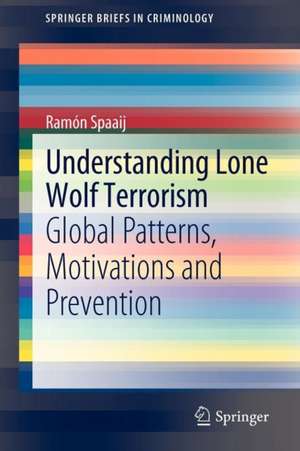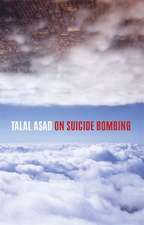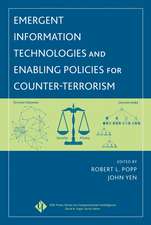Understanding Lone Wolf Terrorism: Global Patterns, Motivations and Prevention: SpringerBriefs in Criminology
Autor Ramon Spaaijen Limba Engleză Paperback – 9 dec 2011
Din seria SpringerBriefs in Criminology
-
 Preț: 356.07 lei
Preț: 356.07 lei -
 Preț: 196.15 lei
Preț: 196.15 lei -
 Preț: 175.58 lei
Preț: 175.58 lei -
 Preț: 377.57 lei
Preț: 377.57 lei -
 Preț: 374.30 lei
Preț: 374.30 lei -
 Preț: 374.30 lei
Preț: 374.30 lei -
 Preț: 374.85 lei
Preț: 374.85 lei -
 Preț: 378.12 lei
Preț: 378.12 lei -
 Preț: 445.49 lei
Preț: 445.49 lei -
 Preț: 374.85 lei
Preț: 374.85 lei -
 Preț: 380.07 lei
Preț: 380.07 lei -
 Preț: 173.25 lei
Preț: 173.25 lei -
 Preț: 378.12 lei
Preț: 378.12 lei -
 Preț: 411.93 lei
Preț: 411.93 lei -
 Preț: 378.54 lei
Preț: 378.54 lei -
 Preț: 372.08 lei
Preț: 372.08 lei -
 Preț: 375.23 lei
Preț: 375.23 lei -
 Preț: 375.45 lei
Preț: 375.45 lei -
 Preț: 375.23 lei
Preț: 375.23 lei -
 Preț: 379.09 lei
Preț: 379.09 lei -
 Preț: 375.07 lei
Preț: 375.07 lei -
 Preț: 343.72 lei
Preț: 343.72 lei -
 Preț: 409.25 lei
Preț: 409.25 lei -
 Preț: 377.35 lei
Preț: 377.35 lei -
 Preț: 376.96 lei
Preț: 376.96 lei -
 Preț: 443.00 lei
Preț: 443.00 lei -
 Preț: 375.07 lei
Preț: 375.07 lei -
 Preț: 378.92 lei
Preț: 378.92 lei -
 Preț: 375.07 lei
Preț: 375.07 lei -
 Preț: 377.57 lei
Preț: 377.57 lei -
 Preț: 376.59 lei
Preț: 376.59 lei -
 Preț: 355.07 lei
Preț: 355.07 lei -
 Preț: 376.43 lei
Preț: 376.43 lei -
 Preț: 376.22 lei
Preț: 376.22 lei -
 Preț: 378.71 lei
Preț: 378.71 lei -
 Preț: 352.97 lei
Preț: 352.97 lei -
 Preț: 374.46 lei
Preț: 374.46 lei -
 Preț: 374.30 lei
Preț: 374.30 lei -
 Preț: 476.79 lei
Preț: 476.79 lei -
 Preț: 376.80 lei
Preț: 376.80 lei -
 Preț: 376.43 lei
Preț: 376.43 lei -
 Preț: 411.54 lei
Preț: 411.54 lei -
 Preț: 478.33 lei
Preț: 478.33 lei - 15%
 Preț: 460.57 lei
Preț: 460.57 lei -
 Preț: 413.07 lei
Preț: 413.07 lei -
 Preț: 375.62 lei
Preț: 375.62 lei -
 Preț: 378.71 lei
Preț: 378.71 lei -
 Preț: 410.39 lei
Preț: 410.39 lei -
 Preț: 375.07 lei
Preț: 375.07 lei
Preț: 475.83 lei
Nou
Puncte Express: 714
Preț estimativ în valută:
91.05€ • 95.32$ • 75.34£
91.05€ • 95.32$ • 75.34£
Carte tipărită la comandă
Livrare economică 05-19 aprilie
Preluare comenzi: 021 569.72.76
Specificații
ISBN-13: 9789400729803
ISBN-10: 9400729804
Pagini: 100
Ilustrații: VIII, 119 p. 7 illus.
Dimensiuni: 155 x 235 x 13 mm
Greutate: 0.14 kg
Ediția:2012
Editura: SPRINGER NETHERLANDS
Colecția Springer
Seria SpringerBriefs in Criminology
Locul publicării:Dordrecht, Netherlands
ISBN-10: 9400729804
Pagini: 100
Ilustrații: VIII, 119 p. 7 illus.
Dimensiuni: 155 x 235 x 13 mm
Greutate: 0.14 kg
Ediția:2012
Editura: SPRINGER NETHERLANDS
Colecția Springer
Seria SpringerBriefs in Criminology
Locul publicării:Dordrecht, Netherlands
Public țintă
ResearchRecenzii
From the reviews:
“A new report has shed light on the growing threat of terrorist attacks carried out by individuals. … For the first time, an in-depth analysis is provided of the key features of lone wolf terrorism worldwide over the last four decades. The report provides insights for those working to prevent or minimize the effects of terrorism and political violence, by exploring what drives the lone wolf terrorist to commit mass violence and discussing how this phenomenon can be countered effectively.” (Newstrack India, December, 2011)
“Understanding Lone Wolf Terrorism thus comes at a welcome time and succeeds in making this complex phenomenon comprehensible. … Ramon Spaaij’s slim but highly significant account is the first to crunch the numbers on lone-wolf terrorism. … this necessary first monograph on the study of lone-wolf terrorism, Spaaij helpfully turns to responses: both professionals’ and the public’s.” (Matthew Feldman, Times Higher Education, May, 2012)
“A new report has shed light on the growing threat of terrorist attacks carried out by individuals. … For the first time, an in-depth analysis is provided of the key features of lone wolf terrorism worldwide over the last four decades. The report provides insights for those working to prevent or minimize the effects of terrorism and political violence, by exploring what drives the lone wolf terrorist to commit mass violence and discussing how this phenomenon can be countered effectively.” (Newstrack India, December, 2011)
“Understanding Lone Wolf Terrorism thus comes at a welcome time and succeeds in making this complex phenomenon comprehensible. … Ramon Spaaij’s slim but highly significant account is the first to crunch the numbers on lone-wolf terrorism. … this necessary first monograph on the study of lone-wolf terrorism, Spaaij helpfully turns to responses: both professionals’ and the public’s.” (Matthew Feldman, Times Higher Education, May, 2012)
Notă biografică
Ramón Spaaij is a Senior Research Fellow in the School of Social Sciences at La Trobe University, Australia, and the Amsterdam Institute for Social Science Research, University of Amsterdam. He has lectured at several universities in the areas of sociology, sport studies and conflict studies. Spaaij’s main research expertise is in the sociology of sport, social capital, socialization, social exclusion, and terrorism and political violence. He has published nine books including recent titles such as Sport and Social Mobility: Crossing Boundaries (Routledge, 2011) and The Social Impact of Sport: Cross-Cultural Perspectives (edited, Routledge, 2010). He is co-author of the book Trends in Terrorisme (Kluwer, 2003) and has published on various aspects of terrorism and political violence. His work has appeared in a wide range of international media.
Textul de pe ultima copertă
What drives the lone wolf terrorist to commit mass violence? What are their ideologies and motivations? How do they plan and carry out their attacks, and who do they target? How can lone wolf terrorism be effectively countered? One of the first in-depth analyses of lone wolf terrorism, this publication sets out to answer these questions. Drawing on extensive international data and qualitative case studies, it examines the global patterns in and key features of lone wolf terrorism over the past four decades. This engaging text will be essential reading for students and researchers on terrorism and violent conflict and offers unique and invaluable insights to those working to prevent or minimize the effects of terrorism and political violence.
Caracteristici
One of the first in-depth analyses of lone wolf terrorism, and the first one to consider lone wolf terrorism worldwide over four decades Identifies and examines the key trends, features and dimensions of lone wolf terrorism Explores what drives the lone wolf to commit mas violence Discusses how lone wolf terrorism can be effectively countered ? Includes supplementary material: sn.pub/extras












